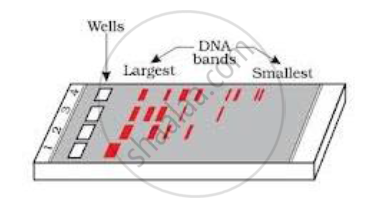Advertisements
Advertisements
Question
Name and describe the technique that helps in separating the DNA fragments formed by the use of restriction endonuclease
Solution
Gel electrophoresis is a technique of separating DNA fragments formed by the action of restriction endonucleases.
The fragments of DNA are placed in a typical agarose gel under an electric field. The DNA fragments move towards the anode as these fragments are negatively charged molecules. The DNA fragments separate according to their size through the sieving effect provided by the agarose gel. The smaller the fragment size, the farther it moves. The separated DNA fragments are stained with ethidium bromide followed by exposure to ultraviolet radiation. The DNA fragments are seen as orangecoloured and are cut out from the agarose gel and extracted from the gel piece. This step is called elution.

APPEARS IN
RELATED QUESTIONS
Do eukaryotic cells have restriction endonucleases? Justify your answer.
Explain briefly:
Restriction enzymes and DNA
Answer the following question.
Write the use of restriction endonuclease in the formation of recombinant DNA.
The total number of nucleotide sequences of DNA that code for a hormone is 1530. The proportion of different bases in the sequence is found to be Adenine = 34%, Guanine = 19%, Cytosine = 23%, Thymine = 19%.
Applying Chargaff’s rule, what conclusion can be drawn?
A mixture containing DNA fragments a, b, c and d, with molecular weights of a + b = c, a > b and d > c was subject to agarose get electrophoresis. This position of these fragments from cathode to anode to anode sides of the gel would be ______.
There is a restriction endonudease called as EcoRI. What does co part in it stands for?
Would you choose an exonuclease while producing a recombinant DNA molecule?
A plasmid DNA and a linear DNA (both are of the same size) have one site for a restriction endonuclease. When cut and separated on agarose gel electrophoresis, plasmid shows one DNA band while linear DNA shows two fragments. Explain.
CTTAAG
GAATTC
- What are such sequences called? Name the enzyme used that recognizes such nucleotide sequences.
- What is their significance in biotechnology?
What is elution?
